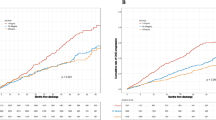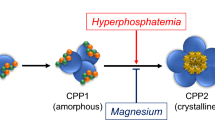Abstract
Introduction
Vascular calcification (VC), which is a pathological process of abnormal calcium and phosphorus deposition in blood vessels, valves, heart and other tissues, is highly prevalent and predicts mortality in dialysis patients. Its mechanisms are complex and unclear. We presume that intermedin (IMD), a kind of small molecule active peptide, may play roles in VC in hemodialysis (HD) patients. This study aims to evaluate serum IMD levels and establish their relation to VC and other parameters in HD patients.
Methods
A total of 116 patients on maintenance HD treatment and 52 age- and sex-matched healthy controls were enrolled in this study. Serum IMD levels were measured by radioimmunoassay (RIA). VC was evaluated by abdominal aortic calcification scores.
Results
Serum IMD levels were significantly lower in HD patients than in controls [24.89 (13.55, 50.24) pg/ml vs. 137.79 (93.21, 201.64) pg/ml, P < 0.0001]. In addition, IMD was negatively correlated with the serum phosphate level (P = 0.036) in HD patients. However, compared with the group whose IMD levels were above the median, patients with IMD levels less than the median had a lower incidence of VC (P = 0.031). Multivariate logistic regression analyses revealed that serum IMD levels more than 24.89 pg/ml (P = 0.014, OR = 0.285), higher serum iPTH levels (P < 0.0001, OR = 1.093) and older age (P = 0.009, OR = 1.003) were significant independent determinant factors for VC in HD patients.
Conclusion
The serum IMD levels were significantly lower in HD patients than that in healthy group. In addition to higher PTH levels and older age, compensatory elevated IMD levels may be an independently determinant factor for VC in HD patients. This was the first study about IMD and VC in dialysis patients.
Similar content being viewed by others
Availability of data and materials
The data and materials in the study were available.
Code availability
The code in the study were available.
References
Gungor O, Kocyigit I, Yilmaz MI, Sezer S (2018) Role of vascular calcification inhibitors in preventing vascular dysfunction and mortality in hemodialysis patients. Semin Dial 31(1):72–81. https://doi.org/10.1111/sdi.12616
He L, He WY, La-Ta A, Yang WL, Zhang AH (2018) Lower serum irisin levels are associated with increased vascular calcification in hemodialysis patients. Kidney Blood Press Res 43(1):287–295. https://doi.org/10.1159/000487689
Roh J, Chang CL, Bhalla A, Klein C, Hsu SY (2004) Intermedin is a calcitonin/calcitonin gene-related peptide family peptide acting through the calcitonin receptor-like receptor/receptor activity-modifying protein receptor complexes. J Biol Chem 279(8):7264–7274. https://doi.org/10.1074/jbc.M305332200
Ni X, Zhang J, Tang C, Qi Y (2014) Intermedin/adrenomedullin2: an autocrine/paracrine factor in vascular homeostasis and disease. Sci Chin Life Sci 57(8):781–789. https://doi.org/10.1007/s11427-014-4701-7
Chang JR, Duan XH, Zhang BH, Teng X, Zhou YB, Liu Y, Yu YR, Zhu Y, Tang CS, Qi YF (2013) Intermedin1-53 attenuates vascular smooth muscle cell calcification by inhibiting endoplasmic reticulum stress via cyclic adenosine monophosphate/protein kinase A pathway. Exp Biol Med (Maywood) 238(10):1136–1146. https://doi.org/10.1177/1535370213502619
Cai Y, Xu MJ, Teng X, Zhou YB, Chen L, Zhu Y, Wang X, Tang CS, Qi YF (2010) Intermedin inhibits vascular calcification by increasing the level of matrix gamma-carboxyglutamic acid protein. Cardiovasc Res 85(4):864–873. https://doi.org/10.1093/cvr/cvp366
Chen Y, Zhang LS, Ren JL, Zhang YR, Wu N, Jia MZ, Yu YR, Ning ZP, Tang CS, Qi YF (2020) Intermedin1-53 attenuates aging-associated vascular calcification in rats by upregulating sirtuin 1. Aging (Albany NY) 12(7):5651–5674. https://doi.org/10.18632/aging.102934
Kauppila LI, Polak JF, Cupples LA, Hannan MT, Kiel DP, Wilson PW (1997) New indices to classify location, severity and progression of calcific lesions in the abdominal aorta: a 25-year follow-up study. Atherosclerosis 132(2):245–250. https://doi.org/10.1016/S0021-9150(97)00106-8
Lee SJ, Lee IK, Jeon JH (2020) Vascular calcification-new insights into its mechanism. Int J Mol Sci 21(8):2685. https://doi.org/10.3390/ijms21082685
Wang Y, Mi Y, Tian J, Qiao X, Su X, Kang J, Wu ZJ, Wang GQ, Zhou XS, Zhou Y, Li RS (2020) Intermedin alleviates renal ischemia-reperfusion injury and enhances neovascularization in wistar rats. Drug Des Dev Ther 14:4825–4834. https://doi.org/10.2147/DDDT.S253019
Morimoto R, Satoh F, Murakami O, Totsune K, Suzuki T, Sasano H, Ito S, Takahashi K (2007) Expression of adrenomedullin2/intermedin in human brain, heart, and kidney. Peptides 28(5):1095–1103. https://doi.org/10.1016/j.peptides.2007.01.018
Dong H, Zhou Y, Wang Y, Zhou Q, Zhang Y, Gan X, Luo YK, Li RS (2019) The protective role of intermedin in promoting angiogenesis during renal fibrosis. Gene 688:34–43. https://doi.org/10.1016/j.gene.2018.11.057
Qiao X, Wang L, Wang Y, Su X, Qi Y, Fan Y, Peng ZQ (2017) Intermedin inhibits unilateral ureteral obstruction-induced oxidative stress via NADPH oxidase Nox4 and cAMP-dependent mechanisms. Ren Fail 39(1):652–659. https://doi.org/10.1080/0886022X.2017.1361839
Lei JF, Zhou Y, Dong HL, Zhao XY, Luo YK, Li RS (2017) Study on glomerular microvascular injury and repair in patients with IgA nephropathy and its relationship with intermedin. Chin J Nephrol 33(6):416–421
Chen P, Zhou Y, Zhou C, Wang QH, Li RS, Wen T, Mao M (2013) Study of changes of plasma intermedin level in patients with chronic kidney disease and its relationship with the levels of homocysteine and cystatin-C. Chin J Clin 7(21):9448–9452
Carrillo-López N, Panizo S, Alonso-Montes C, Martínez-Arias L, Avello N, Sosa P, Dusso AS, Cannata-Andía JB, Naves-Díaz M (2019) High-serum phosphate and parathyroid hormone distinctly regulate bone loss and vascular calcification in experimental chronic kidney disease. Nephrol Dial Transplant 34(6):934–941. https://doi.org/10.1093/ndt/gfy287
Chang JR, Guo J, Wang Y, Hou YL, Lu WW, Zhang JS, Yu YR, Xu MJ, Liu XY, Wang XJ, Guan YF, Zhu Y, Du J, Tang CS, Qi YF (2016) Intermedin1–53 attenuates vascular calcification in rats with chronic kidney disease by upregulation of α-Klotho. Kidney Int 89(3):586–600. https://doi.org/10.1016/j.kint.2015.12.029
Disthabanchong S (2012) Vascular calcification in chronic kidney disease: pathogenesis and clinical implication. World J Nephrol 1(2):43–53. https://doi.org/10.5527/wjn.v1.i2.43
Acknowledgements
We are grateful to all staff of the Hemodialysis Dialysis Center at Peking University Third Hospital and patients who participated in this project.
Funding
This article was supported by the National Natural Science Foundation of China under Grant No. 81873619 and No. 81570663 to Aihua Zhang; The Key Clinical Program of Peking University Third Hospital under Grant BYSY2018024 to Lian He.
Author information
Authors and Affiliations
Contributions
All authors contributed to the study conception and design. Material preparation, data collection and analysis were performed by WB. The first draft of the manuscript was written by WB and all authors commented on previous versions of the manuscript. All authors read and approved the final manuscript.
Corresponding authors
Ethics declarations
Conflict of interest
The authors have no competing interests to declare that are relevant to the content of this article.
Ethical approval
All procedures performed in studies involving human participants were in accordance with the ethical standards of the institutional and/or national research committee and with the 1964 Helsinki Declaration and its later amendments or comparable ethical standards. The study was approved by the Ethics Committee of Peking University Third Hospital (ethical approval number: M2018043). And, all patients signed the written informed consent.
Informed consent
Informed consent was obtained from all individual participants included in the study.
Consent to participate
Informed consent was obtained from all individual participants included in the study.
Consent for publication
The participant has consented to the submission of the article to the journal.
Additional information
Publisher's Note
Springer Nature remains neutral with regard to jurisdictional claims in published maps and institutional affiliations.
Supplementary Information
Below is the link to the electronic supplementary material.
Rights and permissions
About this article
Cite this article
Bao, W., He, L. & Zhang, A. Compensatory elevated serum intermedin levels are associated with increased vascular calcification in hemodialysis patients. Int Urol Nephrol 54, 3001–3007 (2022). https://doi.org/10.1007/s11255-022-03240-2
Received:
Accepted:
Published:
Issue Date:
DOI: https://doi.org/10.1007/s11255-022-03240-2




